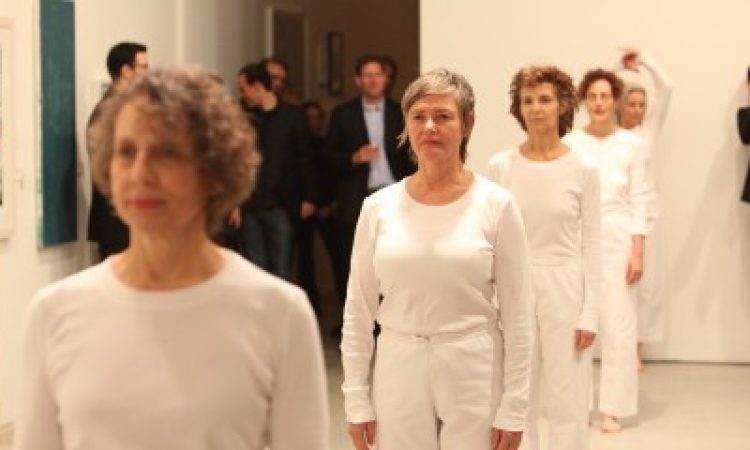Quick – what iconic three-and-a-half minute post-modern dance charms all and elicits hearty laughter, even from those resistant to stripped down movement? And who concocted this confection?
Trisha Brown, who turned 75 this year, referred to herself as a “bricklayer with a sense of humor.” She created Spanish Dance in 1973 when her company was “dancing” pedestrian movement. It was a stand- alone piece, one of a series of “rulegames” that each took place on a line and were later subsumed into Line Up, a collection of such dances interspersed with memorized improvisations created on the instruction “line up.” The effect of watching these dances, as with much of Brown’s early work, is one of witnessing an artist engaged with serious play – both madcap and mercilessly focused.
Spanish Dance begins with five women equally spaced across the front of a proscenium or gallery, stretching from one wall to another. They wear what Wendy Perron, now editor-in-chief of Dance Magazine and a former Brown dancer, termed “arte povera” whites – drawstring pants and long sleeved T-shirts- once cheap, now chic. As Bob Dylan’s rendition of Early Mornin’ Rain plays, the woman furthest to the audience’s right steps in time, gradually unfurling her arms, flamenco style. She paces forward, bumping the knees of the woman in front of her who, in turn, unfurls her arms, and so on, until the pile-up of all the women, hips pressed together and swaying in a sensual unison, is arrested at the very last note of the music by the boundary of the wall. They are squished, just as the song intones “with nowhere to go.”
Dylan’s singing is wistful but light, accompanied by lovely guitar riffs, and the lyrics invoke long distance love and longing. The dancing is stripped down – a simple walk, a one shot gesture, repeated. But it all builds into more than the sum of its parts, creating an experience of bemusement, wonder, and delight: “Are they really going to continue this all the way through?” The postures are an outrageous appropriation from Flamenco of something smoldering in the midst of a cool, near-mathematical score. Trisha’s mind works like that.
To honor Trisha on her 75th, the Sikkema Jenkins Gallery hosted an auction of art by luminaries like Robert Rauschenberg, Chuck Close and Roy Lichtenstein, as well as by lesser but notable lights. I was invited as one of five women, all of whom had danced in Trisha’s company in its early years, to dance Spanish Dance.
What changed when, rather than the twenty and thirty-something bodies of the usual company, the women dancing were all around sixty, one with a mane of silver hair, all with bodies settled into their middle-aged selves? Through the dancing I think we all felt, and the audience could see, our deep devotion to Trisha as an artist and person over the long haul. We were stand-ins for all the many artists who have worked with her through the decades. We represented the forward movement of time; you could compare how we look now to how we looked in the seventies and it would be both arresting and pleasing. There is beauty in older age too. There is beauty in how Trisha has evolved over all those years. And Spanish Dance, like special recipes that inevitably result in a delectable dish, was revealed as ageless, a monument to this genius’ brainy joy and sensuality.
I am often surprised by how Trisha ends her dances. Rather than filling her cup to brimming and closing there, she’ll often end suddenly or take some kind of sharp turn, leading the viewer into unexpected territory. Following that lead, I’ll end by pointing you to other takes on “Spanish” as it’s affectionately called – one by Wendy Perron (here). And the clip of our Spanish Dance with TBDC Alumnae that’s posted here.
Photo: Babette Mangolte c 1977. Pictured L to R: Lisa Kraus, Mona Sultzman, Trisha Brown, Wendy Perron, Elizabeth GarrenTop photo, pictured L to R: Lisa Kraus, Irene Hultman, Vicky Shick, Wendy Perron, Elizabeth Garren
[Many thanks to Diane Madden, longtime dancer with Trisha, and rehearsal director, who set up the performance and who, we calculated, has been part of the company longer than the other five of us put together.]
Editor Note: Lisa Kraus, editor-in-chief of thINKingDANCE, taught Line Up in 2010 at Franklin & Marshall College through a National Endowment for the Arts American Masterpieces grant.






